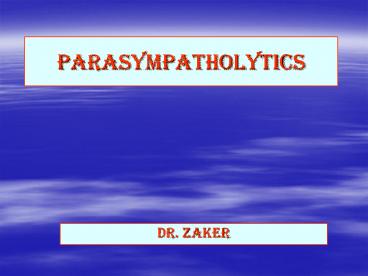Parasympatholytics - PowerPoint PPT Presentation
1 / 17
Title:
Parasympatholytics
Description:
Parasympatholytics Dr. Zaker Good Bye to PANS References Pharmacology by Rang and Dale Katzung Pharmacology Good Bye to PANS References Pharmacology by Rang and Dale ... – PowerPoint PPT presentation
Number of Views:807
Avg rating:3.0/5.0
Title: Parasympatholytics
1
Parasympatholytics
- Dr. Zaker
2
(No Transcript)
3
Cholinergic receptors
Nicotinic receptors Muscarinic receptors
Present in Autonomic ganglia (NN) Adrenal medulla (NN) Motor endplate (NM) CNS (Spinal cord mainly) (NN) Present in Effector organ supplied by Parasymp Sweat glands BV CNS (Brain Mainly)
Blocked By Ganglion blocker (Nicotine, LD, in ganglia) Neuromucular blocker (eg. Curare in skeletal muscles) Blocked by Atropine
4
Drug affecting ANS neuromuscular junction
Sympathetic Sympathetic Parasympathetic Parasympathetic Drugs acting on NMJ
Sympatho-mimetics Sympatho-lytics Parasympatho-mimetics Parasympatho-lytics NMJ Blocking Agents
Adrenergic agonists Adrenergic antagonists Cholinergic agonists Cholinergic antagonists Cholinergics
1. a receptors 2. ß receptors a-antagonist ß-antagonist Selective ß Mixed type Nicotinic Muscarinic 1. Muscarinic antagonists 2. Ganglion blocking drugs 1. Competitive non-depolarizing (Curare, Pancuronium)
Direct acting Indirect acting Direct acting Indirect acting 2. Non competitive depolarizing (Decamethonium, Succinylcholine)
5
Classification of Cholinergic drugs
- Muscarinic antagonists (Parasympatholytics)
- (Atropine, hyoscine, homatropine)
- Ganglion blocking drugs
- (Hexamethonium, gallamine)
- Neuromuscular blocking drugs
- (Calcium antagonists, hemicholinium, magnesium
ions)
6
MUSCARINIC RECEPTOR ANTAGONISTS
- They produce reversible blockade of the action of
ACh at muscarinic receptors competitively. They
have affinity for muscarinic receptors, no
efficacy, and slow dissociation rate. - Classified as
- Natural belladonna Alkaloids Atropine, Hyoscine
(Scopolamine) Both are tertiary ammonium
alkaloids - Synthetic derivatives Homatropine, Ipratropium,
Pirenzepine (Selective M1 antagonist)
7
Atropine
- Pharmacokinetics
- Absorbed orally, can be given by Inj. Metabolized
in liver, distribution to all tissue, t1/2 2hr,
urinary excretion, 60 unchanged - Actions
- Eye
- Mydriasis due to block of muscarinic receptors in
constrictor papillae muscle (passive mydriasis) - Loss of reaction to light (light reflex loss)
- Relaxation of ciliary muscle (cycloplegia--- Loss
of accommodation for near vision) - Impaired aq. Humor drainage (?IOP)
- Decrease lacrimation (local application- effects
last for 7-10 days) - Secretions Decreases saliva, bronchial, gastric
and sweat secretions - Bronchi Bronchodilatation, dryness of secretions
- CVS ? HR, ?AV conduction due to vagal block. Low
doses produce bradycardia followed by tachycardia - BV no effect at therapeutic doses (Most BVs
have no parasymp supply). Blocks VD induced by
muscarinic agonists. Toxic doses cause cutaneous
VD in upper part of body esp. face (Atropine
flush) - GIT ? motility and secretions
- Urinary tract Relaxes detrusor muscle and
contract sphincters - CNS Mainly excitatory, antiemetic and
antiparkinsonian effect
8
Atropine- Therapeutic uses
- Preanesthetic medication to
- Decrease salivary and bronchial secretions
- Antagonize RC depressants
- Protect heart from bradycardia induced by general
anesthetics - Prevent vomiting
- Fundus examination (derivatives are better)
- Heart block, marked bradycardia and carotid
sinus syndrome - Bronchial asthma (secretions become vicid, better
to use ipratropium) - Colics, gut hypermotility and duodenal ulcers
- Nocturnal enuresis and urinary urgency to reduce
bladder motility - Parkinsonism
- Motion sickness but Hyoscine is better
- Hyperhidrosis (excessive sweating)
- In cholinergic poisoning to antagonize muscarinic
effects as in organophospate poisoning or
physostigmine poisoning - Adverse effects
- Dry mouth, blurred vision, tachycardia,
constipation, urine retention, glaucoma, flush,
agitation, delirium and hyperthermia (esp. in
children). - Treatment of toxicity (symptomatic)
- Care for respiration and stomach wash
- Cold foamentation to reduce hyperthermia
9
Hyoscine
- Given orally, also absorbed by skin, Shorter
duration of action with potent effects on eye and
secretions, Less effects on heart - Tertiary amine like atropine, stimulates RC and
CIC, inhibits vomiting centre and basal ganglia.
Produces more marked CNS effects (Sedation,
drowsiness and amnesia). Toxic doses produce
excitation, agitation, hallucination, coma - Uses
- Used like atropine and preferred in preanesthetic
medication of cardiac and thyrotoxic patients - In motion sickness (Hyosine patch on skin)
- In Menieres disease to prevent vertigo
- Antispasmodic
10
Synthetic atropine substitutes
- Mydriatic group Homatropine
- Antisecretory antispasmodic group These show
muscarinic effects on GIt, insignificant central
effects (Quaternary amine) eg. Hyoscine butyl
bromide (Buscopan) - Ipratropium (Atrovent) is muscarinic blocker,
produces bronchodilatation without dryness of
secretions. Quaternary amine, by inhalation in
bronchial asthma
11
ANS
- As mydriatics
- Cyclopentolate eye drops long acting
- Tropicamide eye drops -- short acting
- As Antispasmodic / Anti-ulcer
- Glycopyrrolate, Dicyclomine
- For Overactive Bladder
- Tolterodine.
12
DRUGS AFFECTING GANGLIA
- Ganglion blockers
- Classified as
- Depolarizing ganglion blockers
- Produce initial stimulation then block (Nicotine
large dose) - Competitive ganglion blocker
- Quaternary amines, Hexametonium and
chlorisondamine - Secondary amine (Mecamylamine)
- Trimetaphan short acting histamine liberator,
by I.V., No CNS effects - Actions
- Effects like atropine
- Postural hypotension
- Impotence
- USES
- Trimetaphan used in hypertensive emergency, to
induce controlled hypotension in surgery
13
Act by blocking effects of ACh at the skeletal NMJ
- Competitive non depolarizing agents
- (Gallamine, Pancuronium)
- Compete with ACh for nicotinic receptors at the
NMJ. ?EPP, depolarization threshold is not
reached - USES
- Promote sk muscle relaxation
- Promote endotracheal intubation
- Adjunct to surgical anesthesia
- Limit trauma due to Electroconvulsive shock
- Adverse effects
- Respiratory paralysis
- Histamine release
- Bronchospasm
- hypotension
14
Act by blocking effects of ACh at the skeletal NMJ
- Non-competitive depolarizing agents
- (succinylcholine, decamethonium)
- Desensitize the nicotinic receptors at NMJ, ?
receptor sensitivity - USES
- Promote sk muscle relaxation
- Promote endotracheal intubation
- Adjunct to surgical anesthesia
- Limit trauma due to Electroconvulsive shock
- Adverse effects
- Respiratory paralysis
- Muscle facciculation and pain
- Increased IOP
- Bradycardia (muscarinic effect)
15
Autonomic nervous system
16
Autonomic nervous system
17
Good Bye to PANS
- References
- Pharmacology by Rang and Dale
- Katzung Pharmacology































